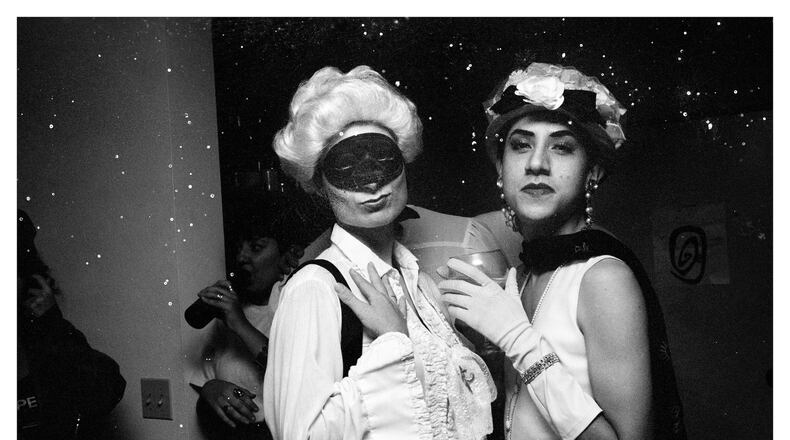It’s hard not to think of family photos taking in the Michael C. Carlos Museum exhibition “You Belong Here: Place, People and Purpose in Latinx Photography.”
Intimate, often political, in a museum context these photographs posit a re-definition of both one’s self and one’s culture. The 16 artists whose work is on view have roots in Mexico, the Dominican Republic, Puerto Rico and Peru among other places. The emerging and established artists have been selected by curator Pilar Tompkins Rivas, chief curator of the Lucas Museum of Narrative Art in Los Angeles. The museum is founded by filmmaker George Lucas (“Star Wars”) and his wife Mellody Hobson and — unsurprisingly — focused on storytelling through images.
The photographs in “You Belong Here” focus on subjects who have been misrepresented or just left out of standard visions of American life, the second half of the title using the gender-neutral term Latinx, which is still the subject of sometimes contentious debate. Descriptive wall text for the work in “You Belong Here” is presented in both English and Spanish. Because of the museum and curator’s home base in L.A. the show has a distinct West Coast bent, often focused on the urban environment and nightclub culture of Los Angeles and surrounding areas, though New York and Chicago also serve as backdrops.
Credit: Handout
Credit: Handout
The images are often portraits focused on subcultures or on families, as in Steven Molina Contreras’s homage to the matriarchs whose strength keeps families united despite life’s challenges. In his family’s case, those challenges included immigration and bridging the gap between New York and El Salvador. In the photograph “Mother Alma #3, She’ll hold you for a lifetime” three generations of women sit on a bed, holding hands or leaning on one another, using each other’s bodies for physical and emotional support. The elaborately carved headboard and expanse of white bedspread gives the composition a faintly religious quality in this formal gathering of love and devotion.
Family of a different sort is captured in late Los Angeles-based artist Laura Aguilar’s black and white images of her naked body as well as patrons at a working class lesbian bar the Plush Pony that show — like Contreras’s work — the necessity of having a tribe, and of feeling like you matter and hold space in the world.
Some of the most delightful works in this vein are celebrated Mexican American artist John M. Valadez’s generous, seductive color street photographs of stylish, nattily dressed hipsters, wonderful time capsules of the hair and clothes and vibe of ‘70s-era Latino youth. In “Clavo” a teenager in white tank top and a hair net that manages to look decidedly chic testifies to the joy of idiosyncratic style. “Alice” (circa 1978) captures a pretty young woman in a tube top and utilitarian, baggy khaki pants, the kind of collision of sexiness and frumpiness that could easily show up on a natty teenager today. The profound self-expression seen in street wear and the self-assurance of Valadez’s subjects is absolutely intoxicating.
Credit: Jori Minaya
Credit: Jori Minaya
Valadez’s work is one of the exhibition’s highlights, as are Joiri Minaya’s complex collaged images of cheesy, hyper-colorful postcards of the Dominican Republic over which Minaya superimposes lush tropical foliage. The postcard images can feel deeply uncomfortable, as with one in which a smiling dark-skinned woman stands on a beach and hoists a tray of tropical cocktails. Minaya sees the creepy association of women and land and how the two become interchangeable as acquiescent, welcoming and exploitable.
Credit: William Camargo
Credit: William Camargo
Though his face is hidden, William Camargo’s documentary-style activations on the streets of Orange County show the artist removing those blaring yellow advertisements nailed to telephone poles advertising for cheap labor or offering cut-rate prices for homes that baldly exploit poorer communities while also littering their neighborhoods with visual clutter. Not all of the work in “You Belong Here” is as obviously political. But Camargo’s streak of flinty disgust with the status quo is palatable and refreshing and offers a voice and attitude that makes some of the other work pale in comparison.
VISUAL ART REVIEW
“You Belong Here: Place, People and Purpose in Latinx Photography”
Through Dec. 3. 10 a.m.-4 p.m. Tuesdays-Fridays; 10 a.m.-5 p.m. Saturdays; noon-5 p.m. Sundays. $8; $6 senior citizens, students and ages 6-17; free for members, Emory students, faculty, staff and children 5 and under. Michael C. Carlos Museum, 571 S. Kilgo Circle, Atlanta. 404-727-4282, carlos.emory.edu.
Bottom line: Some of the best pieces in this survey of feel underpinned with flintiness and disgust with the way these communities are exploited or represented while others are far less urgent and persuasive.
Keep Reading
The Latest
Featured






